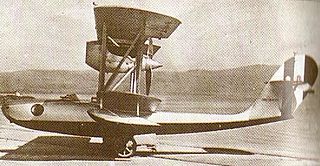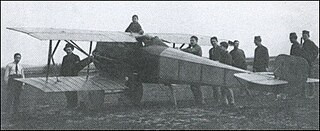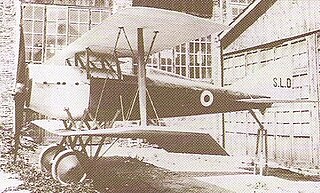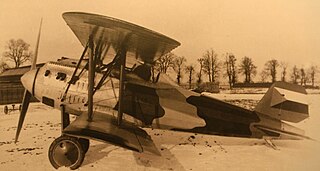| Gabardini G.8 | |
|---|---|
 | |
| Gabardini G.8 | |
| Role | Fighter and trainer |
| National origin | Italy |
| Manufacturer | Gabardini |
| First flight | 1923 |
The Gabardini G.8 was an Italian single-seat aircraft produced in both fighter and trainer versions by Gabardini in 1923.
| Gabardini G.8 | |
|---|---|
 | |
| Gabardini G.8 | |
| Role | Fighter and trainer |
| National origin | Italy |
| Manufacturer | Gabardini |
| First flight | 1923 |
The Gabardini G.8 was an Italian single-seat aircraft produced in both fighter and trainer versions by Gabardini in 1923.
Until 1923, the Gabardini company had produced only instructional aircraft for use by flight training schools, but in 1923 it offered a new aircraft, the G.8, in both advanced trainer and fighter versions. It was the company's first venture into military trainer or fighter production. [1]
The G.8 was a metal single-bay biplane with fabric covering, a frontal radiator, and a two-bladed propeller. The wings were of unequal span, with the upper wing of greater span than the lower, and the aircraft had ailerons only on its upper wing. The trainer version was unarmed and powered by a Hispano-Suiza 8A V8 engine rated at 104 kilowatts (140 horsepower), while the fighter was armed with two 7.7-millimeter (0.303-inch) Vickers machine guns synchronized to fire through the propeller and had a 149-kilowatt (200-horsepower) Hispano Suiza V8. [2]

The G.8 was designed in parallel with the Gabardini G.9 and had a similar wing cellule, but differed from the G.9 in having more cabane bracing and a longer-span upper wing. [3]
Gabardini further developed the G.8 in the G.8bis model. The G.8bis had a 134-kilowatt (180-horsepower) Hispano-Suiza HS 34 engine driving a two-bladed propeller, and differed from the G.8 in having a longer-span lower wing and radiators attached to the sides of its fuselage over the wing leading edges instead of a frontal radiator. [4]
The Regia Aeronautica (Italian Royal Air Force) did not place a production order for either model of the G.8 or for the G.8bis. Gabardini retained all the G.8 aircraft for instructional use at its flight training school at Cameri. [5]
General characteristics
Performance
Armament
Related development

The Fiat CR.20 was an Italian biplane fighter used during the 1920s and 1930s. Designed by Celestino Rosatelli, it represented an intermediate step from the early biplane CR.1 and the later, successful series CR.30, CR.32 and CR.42.

The Fiat CR.1 was an Italian biplane fighter aircraft of the 1920s. Of wood-and-fabric construction, it was designed by Celestino Rosatelli, from whom it gained the 'CR' designation. Its most distinctive feature was that the lower wings were longer than the upper ones.

The Dewoitine D.1 was a French single-seat fighter aircraft of the 1920s, built by the French industrial company Dewoitine.

The CANT 25 was an Italian shipboard single-seat sesquiplane flying boat fighter that entered service with the Regia Aeronautica in 1931.

The SIAI S.52 was an Italian fighter prototype of 1924.

The Caproni Vizzola F.6 was a World War II-era Italian fighter aircraft built by Caproni. It was a single-seat, low-wing cantilever monoplane with retractable landing gear. Only two prototypes were built, one designated F.6M and the other designated F.6Z.

The Piaggio P.2 was an Italian fighter prototype of advanced design built by Piaggio in 1923.

The Gabardini G.9 was an Italian single-seat biplane fighter prototype produced by Gabardini in 1923.

The Ducrot SLD was an Italian fighter prototype built by Ducrot in 1918.

The Marchetti MVT, later renamed SIAI S.50, was an Italian fighter of 1919 and the early 1920s.

The SIAI S.58 or Savoia-Marchetti S.M.58 was an Italian flying boat fighter prototype of the 1920s designed and manufactured by SIAI.

The Macchi M.26 was an Italian flying boat fighter prototype of 1924 designed and manufactured by Macchi.

The Macchi M.41 was an Italian flying boat fighter prototype of 1927 designed and manufactured by Macchi. Its production model, the M.41bis, first flown in 1929, was in front line service from 1930 to 1938.

The Tebaldi-Zari was an Italian fighter prototype of 1919. The Breda company later acquired the rights to it.

The Nieuport-Delage NiD 120 series was a series of French single-seat parasol monoplane fighter aircraft of the 1930s. It was built in a number of versions, fitted with various types of engines, with six aircraft designated NiD 123 being sold to Peru.

The Nieuport-Delage NiD 48 was a French single-engine parasol wing light fighter aircraft, designed and built in the 1920s. Its performance was not markedly better than that of the much heavier Nieuport-Delage NiD 62 then going into production, so only two were flown.

The Wibault 8 or Wib 8 Simoun (Simoon) was a tandem seat, parasol wing fighter aircraft designed and built in France to a 1925 specification which was later withdrawn; only one Wib 8 was completed.
The Wibault 9 or Wib 9 was a single seat, parasol wing fighter aircraft designed and built in France in the 1920s. It was a re-engined version of the relatively successful Wib 7, but failed to reach production.

The Wibault 13C.1 Trombe (Whirlwind), later known as the Wib 130C.1 Trombe was a single seat, parasol wing lightweight fighter aircraft designed and built in France in the 1920s. It was developed into the more powerful Wib 170C.1 Tornade (Tornado) but government interest in lightweight fighters soon waned.

The Letov Š-7 was a single-seat, single-engine biplane fighter aircraft designed and built in Czechoslovakia in the early 1920s. It was designed for a single-seat fighter competition but did not reach production.